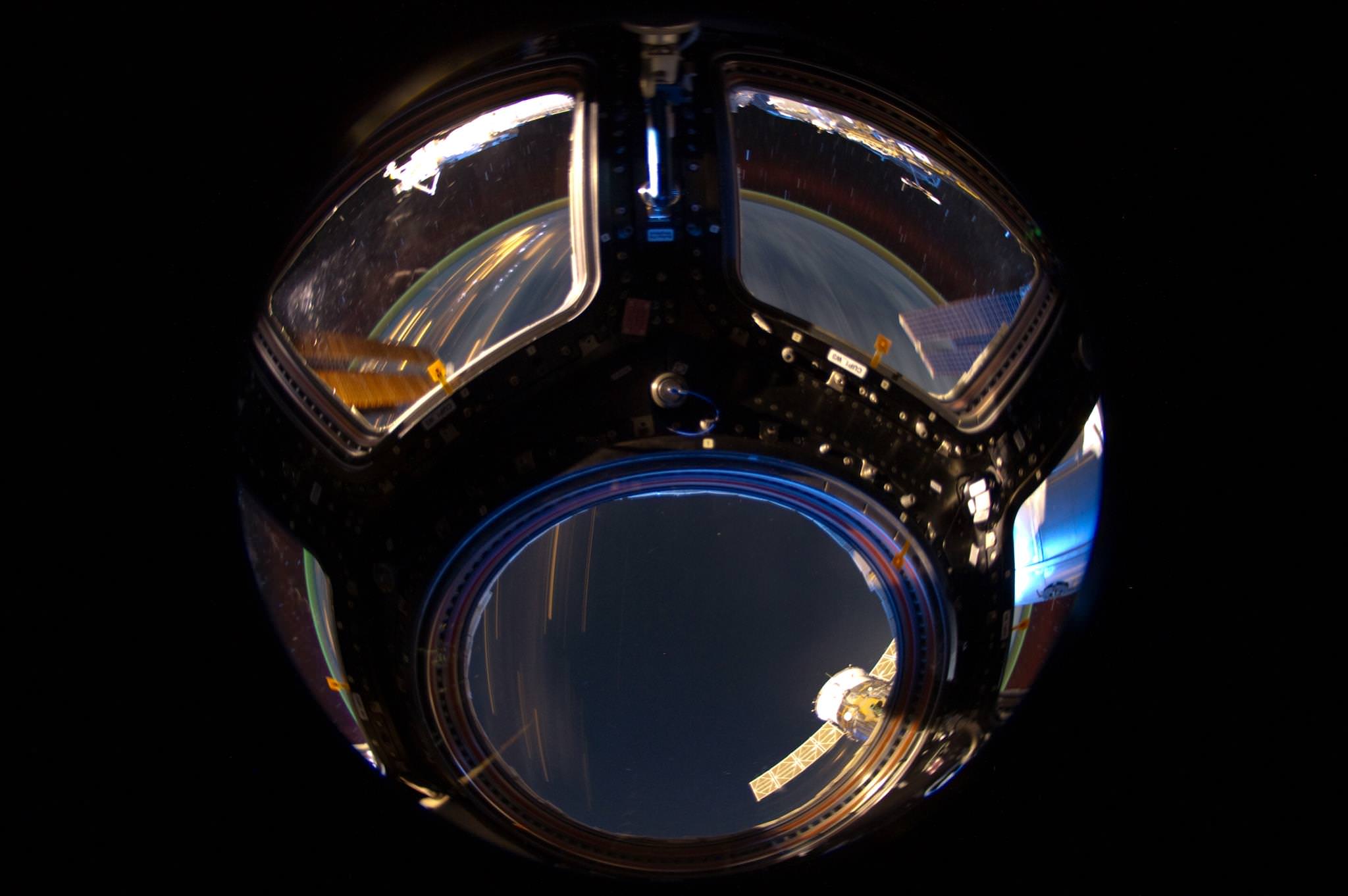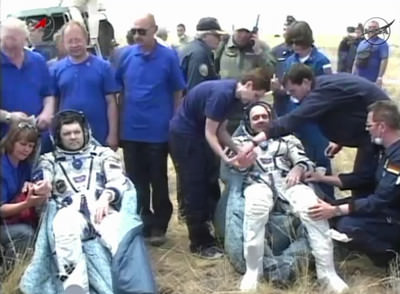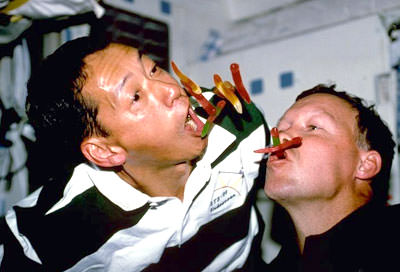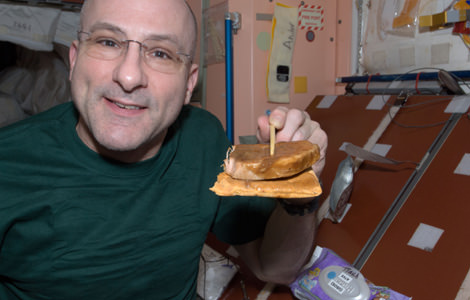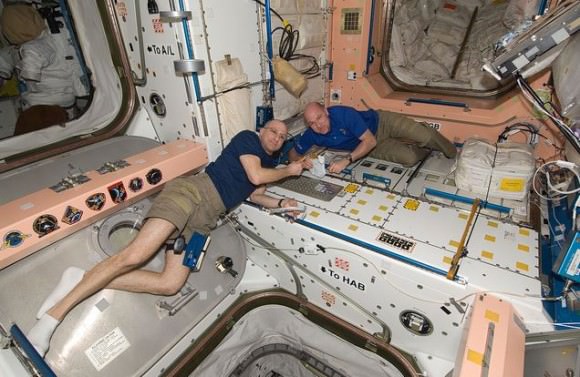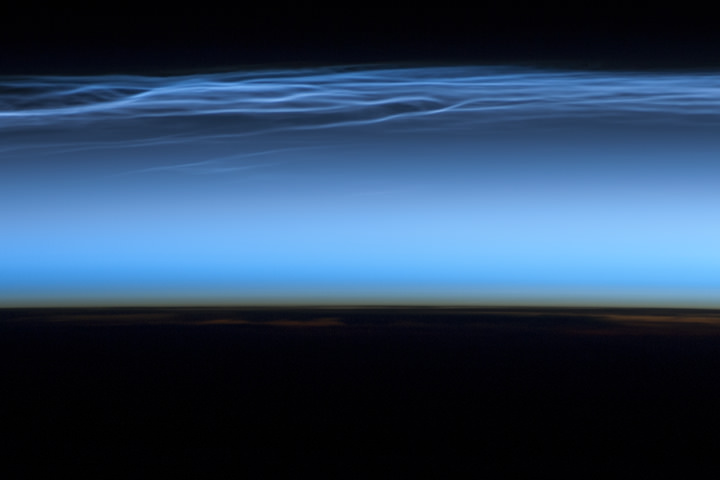What an awesome image of the Cupola on the International Space Station, with a view of Earth whizzing by! But, is the astronaut-photographer on the outside looking in, or on the inside looking out of the Cupola? We know it is taken from the inside, with a view of the Pacific Ocean near Mexico’s Baja Peninsula, but it offers a stunning and futuristic — if not somewhat perplexing — perspective. It was captured at 04:59 GMT June 26, 2012. Credit: NASA
ISS Expedition 31 Crew Returns Safely to Earth
We’re sure going to miss Don Pettit’s and Andre Kuipers’ reports and images from the International Space Station. Pettit, Kuipers and Russian Commander Oleg Kononenko undocked from the International Space Station and returned safely to Earth on July 1, wrapping up their six-and-a-half-month mission in orbit.
They landed in their Soyuz TMA-03M spacecraft in Kazakhstan at 08:14 a.m. UT (2:14 p.m. local time) after undocking from the space station’s Rassvet module at 04:47 UT. This video shows a great view of the Soyuz slowly drifting down (it’s interesting to see the parachute undulate, looking almost like a jellyfish!) and then visible are the breaking thrusters firing just a second before the hard landing.
The trio originally arrived at the station back on Dec. 23, 2011, and during this mission spent a total of 193 days in space, 191 of which were aboard the station.
During their expedition, the crew supported more than 200 scientific investigations involving more than 400 researchers around the world. The studies ranged from integrated investigations of the human cardiovascular and immune systems to fluid, flame and robotic research. They also were part of the team that successfully berthed the first commercial spacecraft to visit the ISS, the SpaceX Dragon capsule.
Before leaving the station, Kononenko handed over command of Expedition 32 to the Russian Federal Space Agency’s Gennady Padalka, who remains aboard the station with NASA astronaut Joe Acaba and Russian cosmonaut Sergei Revin. NASA astronaut Sunita Williams, Russian cosmonaut Yuri Malenchenko and Japan Aerospace Exploration Agency astronaut Akihiko Hoshide will join them July 17. Williams, Malenchenko and Hoshide are scheduled to launch July 14 from the Baikonur Cosmodrome in Kazakhstan.
During Expedition 31, Pettit used household objects aboard the station to perform a variety of unusual physics experiments for the video series “Science Off the Sphere,” like his recent video showing water balloons in space. Through these demonstrations, Pettit showed more than a million Internet viewers how space affects scientific principles.
On June 25, Pettit reached a milestone: spending one cumulative year in space, combining his time in orbit on Expedition 6, Expedition 30/31 and the STS-126 space shuttle Endeavour flight to the station in November 2008. Pettit now has 370 days in space, placing him fourth among U.S. space fliers for the longest time in space.
Kuipers conducted over 50 scientific experiments for ESA, and shared, almost daily, images and reports of his stay in space. The next ESA astronaut to board the Space Station is Luca Parmitano of Italy, who will fly on Soyuz TMA-09M in 2013 as member of Expedition 36/37.
Don Pettit’s Guide to Space Etiquette: Having Guests for Dinner
If you haven’t been reading astronaut Don Pettit’s “Letters to Earth” – a diary of his 6-month stay in space – it’s a great look at living on board the International Space Station. He talks about everything from the big events to the minutia of daily life. His latest entry about being a gracious host in space is classic Pettit: detailed, precise, with just a hint of snark. We present it in its entirety here:
It does not matter that you’ve seen the same faces every day for months on end; you’d still like to invite everyone over to “your module” for dinner. With invitations accepted, you prepare for the occasion. But what is the expected etiquette for entertaining in orbit? How do you arrange things so your guests will not think you are gauche? Here are a few space-tested guidelines to help in the preparations.
Have plenty of food, and serve your very best. Now is the time to break out those thermal-stabilized pouches of beef steak that you have been hoarding. Bring out any specialty item from your personal crew allotment (these items arrive on the periodic unmanned resupply spacecraft that visit us). Perhaps you can share a can of smoked anchovies, New Mexico green chili, or a piece of Old Amsterdam cheese. Always serve something special that is not repeatedly eaten on the standard nine-day menu. Being generous now will reap more benefits than eating these delicacies in solitude.
The choice of beverage is rather limited. You can serve the standard ones: coffee, tea, and artificially flavored, artificially colored, sugar-loaded, fruit-replica drinks. All, of course, are served in a bag, and you sip the fluid through a straw. The image of an insect sucking the juices from some lower insect may come to mind, but in space it is considered impolite to give voice to such imagery.
You can provide a special treat if you have access to one of the research refrigerators. In space, all your food is either hot or at room temperature. When you live in an isothermal environment, it can be a real treat to serve your guests a bag of cold water.
For special occasions—perhaps after a space walk or the docking of a resupply vehicle—you can serve your beverages in a “zero-g” cup. This is something you will have to make from scrap plastic sheeting (instructions are in Appendix C). These cups allow you to sip beverages from an open container, like we do on Earth. Zero-g cups, unlike bags with straws, are better for social rituals like toasting, and will bring a smile to the faces of your guests.
It is important to dress up your galley. Have full packets of wet and dry wipes within easy reach on the galley table. Take any partial packets and save them for another time. Empty the trash bins. A full trash bin is problematic; a handful of small things typically float out when new items are added. This rudely interrupts conversation while everyone scatters to collect the floating debris. It is good to have two trash bins; the standard-sized one for largish items, and an old wet wipe container for small ones. This separation of smaller trash—cutoff pouch corners, food crumbs, and wrappers—helps prevents their release when the lid is opened. Be sure to label this wet wipe container “trash”. Newly arrived crew may not be aware of this trash protocol, so it is best to politely demonstrate by example. They will learn quickly enough.
Clean the food scissors. Scissors are needed to open food pouches, as tearing them along the built-in perforations usually results in liberating hot droplets of fatty ooze and other asteroid-like particles. That’s why, if the scissors aren’t kept clean, they become caked in solidified gravy to the point where they become glued shut (not to mention being slightly repulsive). Such a state is considered rude, so clean your scissors before the guests arrive.
Always have a loaner spoon available. In weightlessness, it is easy to lose things. It is not unusual in a group of six for someone’s spoon to have floated off. Having a clean loaner spoon allows for the evening to continue and the conversation to flow. It is rude to give your guest a loaner spoon caked in crud from the last time it was used. The lost spoon is usually found by morning, stuck to a ventilator inlet screen, and your guest will appreciate it being returned.
Always put out new tape. The galley table has multiple spots of Velcro to park packets of food. However, not all packets and pouches have mating spots of Velcro, which means they can’t be set down on the table. Several strips of duct tape, carefully folded so the adhesive side is out (see Appendix D for instructions), allows such containers to be parked on the table. Tape left over from the previous week, while perfectly functional, collects errant crumbs, hairs, lint, and other unsightly things. Displaying dirty tape is exceedingly rude to your guests; always put out new, clean tape.
In space, catching food in your mouth is considered polite. Opening wide and making a clean catch will most always bring cheers from your guests. In one impressive gulp, you can leave them with the image of some sea creature inhaling another. Catching food in your mouth, like belching at the table (considered impolite in most cultures, but a compliment to the chef in others) is rude on Earth but de rigueur in space.
By following these simple rules, you will ensure a delightful evening with your guests. And remember, on the space frontier, the etiquette book is still being written. I encourage you to invent new ways of conducting everyday life, including entertaining. It is one of the reasons we find ourselves here in the first place.
Source: NASA Blogs
Image captions:
Astronauts eats gummy worms in space. Credit: NASA
Don Pettit displays his favorite snack in space. Credit: NASA
NASA astronaut Don Pettit (left) and European Space Agency astronaut Andre Kuipers, both Expedition 31 flight engineers, eat a snack in the Unity node of the International Space Station. Credit: NASA
Mysterious Noctilucent Clouds as Seen from the International Space Station
Mysterious “night shining” or noctilucent clouds are beautiful to behold, and this stunning image offers an unusual view of these clouds as seen by astronauts on board the International Space Station. Also called polar mesospheric clouds, these clouds are puzzling scientists with their recent dramatic changes. They used to be considered rare, but now the clouds are growing brighter, are seen more frequently, are visible at lower and lower latitudes than ever before, and sometimes they are even appearing during the day.
The astronauts were also able to take a time-lapse sequence of these clouds on June 5, 2012, as seen below. According to NASA, it is first such sequence of images of the phenomena taken from orbit.
The sequence in this video was taken while the ISS was passing over western Asia. By focusing on the limb of the Earth at night with the Sun illuminating it, the crew was able to capture some movement to these mysterious clouds.
There is quite a bit of debate for the cause of noctilucent clouds. Dust from meteors, global warming, and rocket exhaust have all been tagged as contributors, but the latest research suggests that changes in atmospheric gas composition or temperature has caused the clouds to become brighter over time.
Noctilucent clouds are usually seen during the summertime, appearing at sunset. They are thin, wavy ice clouds that form at very high altitudes (between 76 to 85 kilometers (47 to 53 miles) above Earth’s surface and reflect sunlight long after the Sun has dropped below the horizon. They appear in both the Northern and Southern Hemisphere and appear as delicate, shining wispy clouds against the dark sky.
The top image from the ISS was taken on June 13, 2012, as the space station passed over the Tibetan Plateau. At the same time, polar mesospheric clouds were also visible to aircraft flying over Canada. In addition to the noctilucent/polar mesospheric clouds trending across the center of the image, lower layers of the atmosphere are also illuminated. The lowest layer of the atmosphere visible in this image—the stratosphere—is indicated by dim orange and red tones near the horizon.
Lead image caption: Noctilucent or Polar Mesospheric clouds captured by the crew of the ISS on June 13, 2012. Credit: NASA
Source: NASA Earth Observatory
Shenzhou-9 Crew Docks and Enters Chinese Spacelab
The crew of the Chinese Shenzhou-9 spacecraft docked today with the Tiangong-1 mini-spacelab and the three taikonauts entered the small spacelab for the first time. China becomes only the third nation to have a manned craft rendezvous and dock with another spacecraft, behind the U.S. and Russia. Commander Jing Haipeng led the crew into the lab, followed by Liu Wang and then later Liu Yang, China’s first female taikonaut. The Shenzhou capsule completed the docking maneuvers shortly after 0600 UTC (2 am EDT). The two spacecraft are about 343 kilometers (213 miles) above Earth. The docking was shown live on national television.
This docking was automated and monitored by China’s mission control. A manual docking by the crew will be done later in the mission.
The docking video is below.
Continue reading “Shenzhou-9 Crew Docks and Enters Chinese Spacelab”
Timelapse of a Moonrise as Seen from the ISS
Astronaut Don Pettit continues to ‘wow’ us all with his photographic exploits. In this great timelapse video, not only does Pettit capture a stunning Moonrise over Earth, but he had the presence of mind to set up his video camera in such way that he could also show himself opening the shutters in the space station’s Cupola observation windows just in time to watch all the action. The time-lapse scene was photographed from the airlock of the ISS’s Russian segment.
Videos: Dragon Capsule Now Successfully Attached to ISS
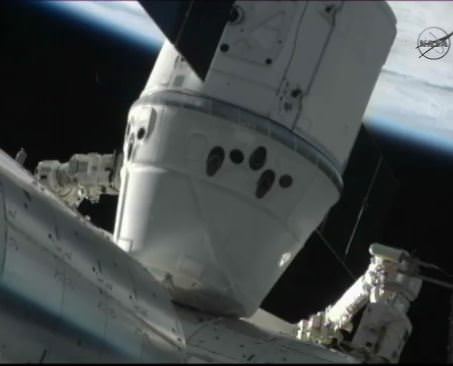
This day will go down in history as the first time a commercial company has their own spacecraft attached to the International Space Station.
After Don Pettit grappled SpaceX’s Dragon capsule with the CanadArm2, Andre Kuipers later installed the capsule on the nadir port of the station’s Harmony node at 15:02 UTC/11:52 a.m. EDT. NASA astronaut Joe Acaba completed berthing operations by bolting the Dragon to Harmony at 16:02 UTC/12:02 p.m. EDT to the space station Friday.
Congratulations on a wonderful capture,” astronaut Megan Behnken radioed to the station crew from Mission Control. “You’ve made a lot of folks happy down here, over in Hawthorne and right here in Houston. Great job, guys.”
More videos, including the post-docking press conference with a jubilant Elon Musk and his SpaceX team.
“Today marks another critical step in the future of American spaceflight,” NASA Administrator Charles Bolden said. “Now that a U.S. company has proven its ability to resupply the space station, it opens a new frontier for commercial opportunities in space — and new job creation opportunities right here in the U.S. By handing off space station transportation to the private sector, NASA is freed up to carry out the really hard work of sending astronauts farther into the solar system than ever before.”
The plan is to wait until Saturday to open hatches. The spacecraft is carrying nearly 460 kg (1,150) pounds of equipment and supplies: 674 pounds of food and crew provisions; 46 pounds of science hardware and equipment; 271 pounds of cargo bags needed for future flights; and 22 pounds of computer equipment.
“The crew is pretty excited so don’t be surprised if they want to open the hatches a little early,” said ISS Flight Director Holly Ridings at a press conference.
The schedule has Dragon remaining berthed to the ISS until May 31. The CanadArm2 will unberth the capsule and then release it. Dragon is the only cargo ship designed to return to Earth with experiments and equipment; others ships such as the Russian Progress, the European ATV and the Japanese HTV all burn up in the atmosphere. The Russian Soyuz crew craft can bring home limited equipment.
[/caption]
Tally Ho Dragon!
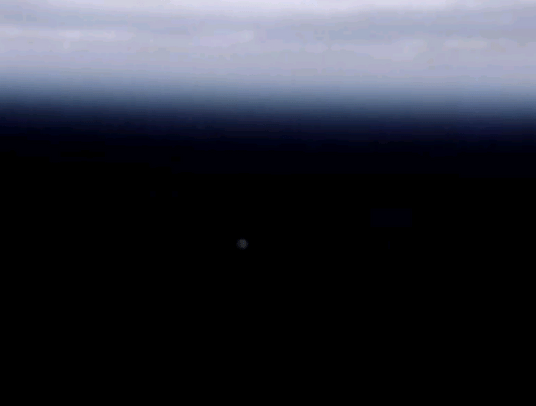
Early today, SpaceX’s Dragon capsule successfully flew near the International Space Station and completed two big tests of its in-space capabilities, all critical tests for tomorrow’s big event: the first berthing of a commercial spacecraft to the ISS. As Dragon approached, astronaut Don Pettit spied the spacecraft first. “I think I can see it now,” he said, and Mission Control in Houston radioed back, “Copy that. Tally ho Dragon!”
With the successes today, NASA has given SpaceX a “go” for berthing activities on Friday, May 25.
[/caption]
Dragon initially appeared as a spot of light against the blackness of space, and later the outline of the capsule and its solar arrays became visible. It came within 2.4 km from the ISS.
Dragon communicated with the ISS and demonstrated its relative GPS, and the astronauts on the ISS successfully communicated back with Dragon by turning on its outside strobe light. The vehicle demonstrated both a pulsed and a full abort, as well as free drift, floating freely in orbit as it will when grappled by the space station’s robotic arm. And its proximity operations sensors and SpaceX’s COTS UHF Communication Unit (CUCU) all worked well during tests today.
Finally, Dragon completed a final height adjustment burn at 12:09 UTC/7:09 a.m. CDT to depart the close vicinity of the Space Station, and then began a “racetrack” trajectory to re-approach the station for grapple and berthing attempts on Friday.
“It went very close to how we had trained for it,” said ISS Flight Director Holly Ridings at a press briefing following Dragon’s maneuvers. The only glitch was a computer monitor on the space station that froze and had to be re-booted.
“Right now our mission is looking just like our simulations,” said John Couluris from SpaceX, lead mission director for the COTS 2 flight. “Today was a big confidence boost. It’s exciting being an American and putting an American spacecraft into orbit.”
Friday’s berthing will be the big test, as Dragon will do a series of burns to bring it closer to the ISS. As Dragon flies around the ISS, there are several decision points where NASA and SpaceX will check the health of the spacecraft. Each point has a “go” sequence if all is going well. When Dragon is about 10 meters away from the Station, all conditions will be assessed in order to give the final “go” for berthing. Both vehicles will be put in free drift so that no thrusters fire, and Kuipers and Pettit will use the Space Station’s Canadarm2 to grab the Dragon and berth it to the complex. Once attached, the crew will have a week to unload the supplies and then put contents in that is scheduled to return to Earth.
Dragon is the only cargo ship designed to return to Earth with experiments and equipment; others ships such as the Russian Progress, the European ATV and the Japanese HTV all burn up in the atmosphere. The Russian Soyuz crew craft can bring home limited equipment.
The initial maneuvers will start at about 06:00 UTC on May 25 (1 am CDT), with capture now scheduled for 12:00 UTC/7 am CDT, and berthing scheduled for about 15:30 UTC/10:30 am CDT. “The timing may move back or forth depending on how much time we need to evaluate the spacecraft as it sits below station in that R-bar location,” said Ridings.
Dragon is the first US-made ship to come to the ISS since about a year ago when the last space shuttle flew.
Launch Images of the SpaceX Dragon’s First Flight to the Space Station
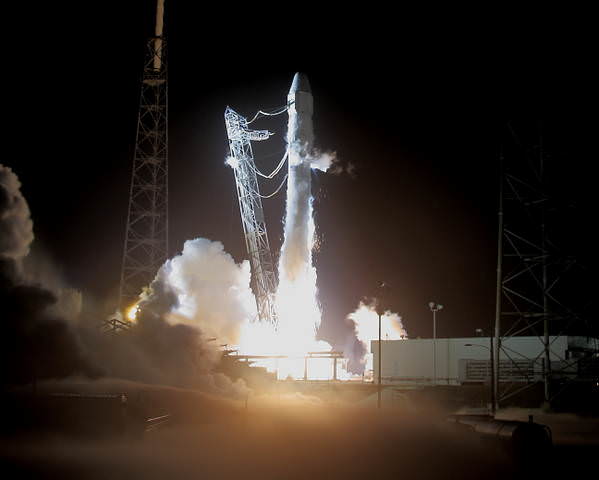
[/caption]
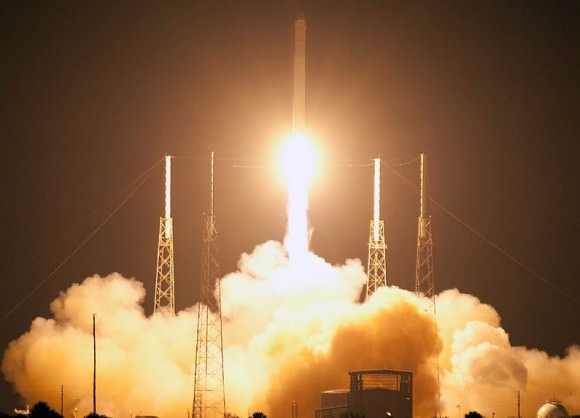
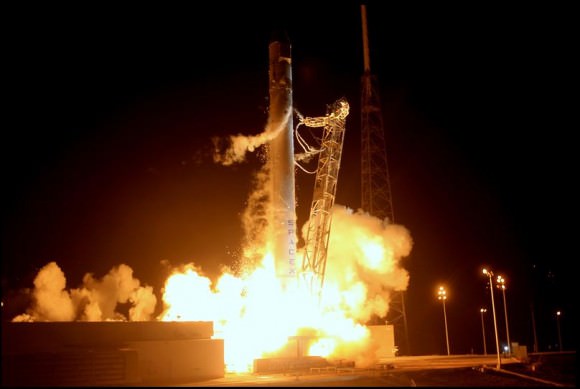
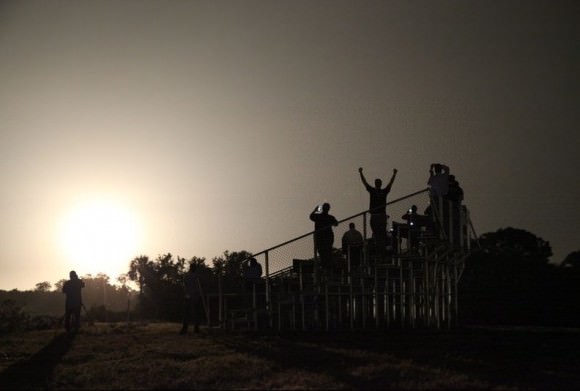

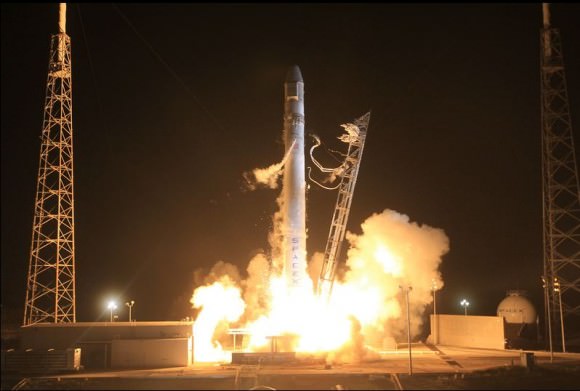
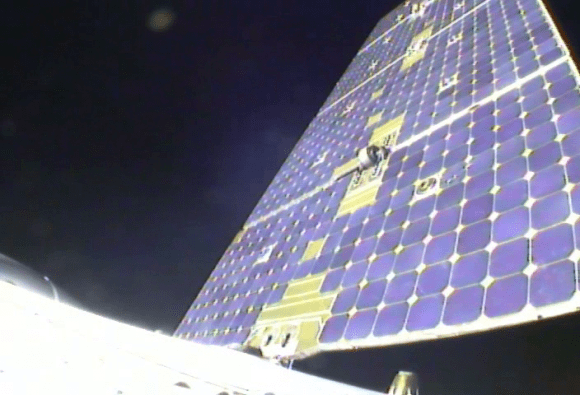
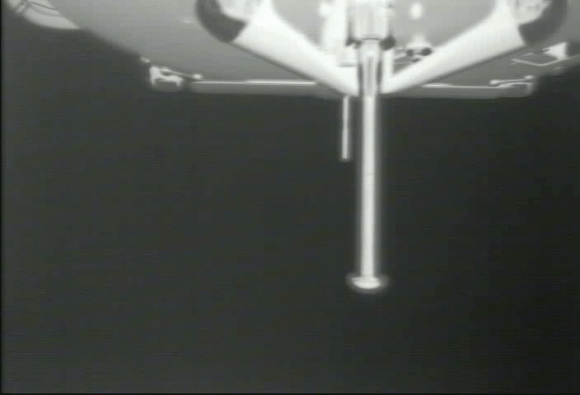
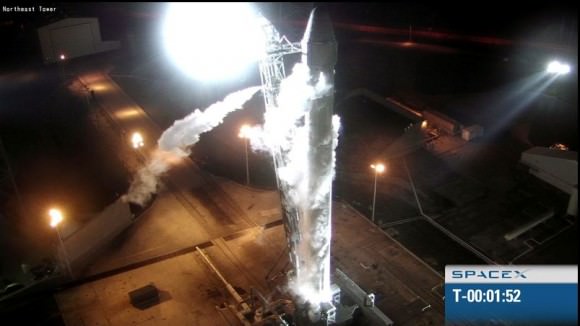
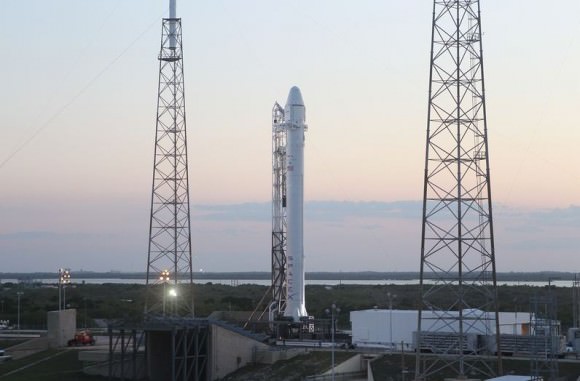
Awesome Videos: Cheer Along with SpaceX Employees
If these videos don’t get your heart pumping or your eyes misting, I don’t know what will. Let’s all cheer along with SpaceX on their incredible accomplishment today! As has been said on Twitter, these are the people who really powered today’s launch.
More below:
Continue reading “Awesome Videos: Cheer Along with SpaceX Employees”

